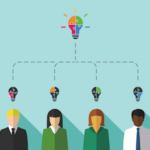
About a decade ago, Andrew Zolli, a founder of PopTech, a nonprofit network that holds an annual conference focused on social innovation, began to notice a change in the way that the people he worked with talked about risk. These were scientists, engineers, designers, and technologists, all working toward solutions to some of the world’s toughest problems. “And in all those different disciplines and different perspectives, people started to shift. They used to talk about risk mitigation and risk avoidance — how do we steer around that problem?” he said in a recent interview with Convene. “Now they were starting to talk about the fact that some of these problems are going to be with us forever, and we have to steer through them.”
Zolli, author of the 2012 book Resilience: Why Things Bounce Back, embarked on a multidisciplinary study of how people and communities, societies, and ecosystems are able to persist, recover, or thrive in the midst of disruption. “That’s the essence of resilience,” said Zolli, the Opening General Session speaker at Convening Leaders 2015 next month. “In this period of great volatility and change, we need the ability to continue to grow, but we also have to make sure that when surprises come at us, they don’t knock us all the way off the horse.
“Living in a period of great disruption and volatility is a profound leadership challenge for every organization in every industry, and it is a profound challenge to us as professionals,” he said. “But it’s also a profound challenge to us as citizens and family members.”
When I met with Zolli at a café in Brooklyn, where he lives with his wife and two children, our sprawling conversation reflected the fact that resilience is not a topic that is easily corralled. We talked for well over an hour about the new primacy of networks, how stress zaps resilience, and the importance of trust and diversity in organizations, with an animated Zolli inviting me to tap my fingers on the table along with him, and borrowing my pen to draw graphs to illustrate psychology experiments. “Human beings are not well suited to seeing change around them when it’s occurring,” he said. But we can get better at that, he said — and learn strategies that maximize resilience.
Here are some of Zolli’s thoughts on resilience:
ON NETWORKS
Networks have become a fundamental organizational principle of the 21st century, in some part supported by technologies that have made it less expensive for people to connect and easier to stay connected. Those digital networks will never replace the analog experiences we have — digital makes the analog more important, not less important. It sort of forms the rope that we swing on between times we see each other in person, like Tarzan swinging from tree to tree from the event, from convening to convening.
I believe that most organizations have no idea how to run networks…. [They] don’t really understand how to breathe life into their networks, how to really get value out of them. And at PopTech, we’re really effective at putting value in and getting value out.
The first rule of all network building — number one, and in neon letters — is you build them before you need them. A lot of organizations build networks only when they’re in trouble or they’re reaching out. The first time to reach out is not when you’re trying to grab a life preserver.
And the second rule, and it’s a complement to the first rule, is that you invest in generosity. A lot of organizations build networks, and their first [act is to ask,] “What can you do for me?” The first thing you ask a network to do cannot be to do your homework or paint your house, right? Instead, you have to do for the network.
The third rule is that you model the behavior you want to see. If I want to see generosity of ideas and time and intention, I model it.
The fourth rule is that networks are not about you. You may pull great value out of them, but they have to be about more than individual relationships. Because what will happen is, the network grows, and it grows bigger and faster. You can only manage, let’s say, 100 relationships. Well, what happens when you get to 101? What happens is that 101st relationship actually harms the other ones.
So what you want to be doing in building a network is actually connecting people to one another — that’s the principle form in which value is created. If I invite you into a community and then I’m bringing you in and connecting you in the right ways, I bring you into that network not so that you’re connected strongly to me, but that you might be connected strongly to others. Then the network shares the load.
The next rule is that roles have to be really clear. What makes a Buddhist a Buddhist, a Mormon a Mormon, a bowling club member a bowling club member? Typically, it’s a set of shared beliefs and values, shared experiences. One of the most powerful dimensions of the work I’ve been doing around resilience is that the network will feel that they take on the identity of being in that group — [being part of the network] is not just something that I do, it’s who I am.
It means that the convener at the center doesn’t have 100 percent of the power. It also means that people who are on the periphery of the network can invite people in. You have to empower people and you have to let collective ownership be taken on for collective outcomes.
ON TRUST
After Hurricane Sandy hit [in October 2012], the Rockefeller Foundation funded a National Opinion Research Council (NORC) study where they looked at communities that were affected by the superstorm, where people were washed out of their houses here in New York. And what they found was that — after controlling for socioeconomic income, property damage, and the like — communities where people reported trusting their neighbors recovered on average twice as fast as ones where they said they didn’t trust their neighbors.
So one of the major things I’m going to be talking about at Convening Leaders is what social scientists are learning about trust. And one of the amazing things is that we’re really hardwired for it.
One of the examples I’ll give is the work of a wonderful colleague of mine named David DeSteno, a psychologist at Northeastern University, who studies the psychology and social science of trust. [In one experiment, DeSteno found that] just tapping your finger in unison with a stranger on a table for two minutes increased cooperative behavior threefold. Human beings are just looking for excuses to go, “This is a member of my tribe.” It can be anything. It can be, “You and I are both wearing black pumps,” or “You and I have the same kind of glasses,” or “We’re roughly the same age,” or “We know that person in common.” Think about all the little ways in which we try to find the common thing between us. A big part of my work now is more about, how do you take these kinds of lessons [in trust building and network creation] and put them into practice?
ON DIVERSITY
One of the lessons of resilient organizations is they have a lot of what’s called cognitive diversity. We spend a lot of time talking about diversity when it comes to racial, ethnic, gender, age — the kind of obvious categories, the ones you can see with your eyes. And those are important. But the kind of cognitive diversity I’m talking about is the kind that allows you to have people who think stylistically differently from each other about the same problems and with the same set of values.
Our natural tendency is to hang out with people like us, to cluster with people who look like us and think like us. In organizations, people have a tendency to get promoted because they think the way the boss does, right? That’s totally the normal way of doing it. The world, however, is going to bring us into an environment where having lots of different styles of thinking and having a tolerance for a diversity of thinking is going to be really important.
ON STRESS
When you spend time with senior leaders, it usually takes a while to build trust. Eventually you become trusted, and what you hear is, “Our people are miserable. Our staff is burned out. We’re an engine of burnout.” Or, “You can only get into my position by essentially annihilating your family, annihilating your support structure, and overcommitting.”
It’s a problem of incentives. It’s a problem of organizational culture. If you look at the arc of getting into a leadership position, we expect you to survive all of this. But what’s happening is that HR directors, people, talent directors, and increasingly recruiters, are saying, “You know what? We see what it’s like here. And we’re having trouble retaining people. We don’t want to sign up for this.”
The issues of staff burnout — really deep stress — are profoundly affecting organizations. And they affect them in every kind of walk of life. It affects police on the beat, it affects firefighters and first responders, and it affects corporate executives at some of the most important high-tech companies.
There is a huge transition underway. It’s a transition toward greater wisdom, mindfulness. You can see there’s a kind of resurgent practice, and this is a big part of organizational resilience: Resilient organizations are made of resilient people.
ON OPTIMISM
My work brings me into contact regularly with things that are incredibly depressing and incredibly exciting, and that give me real reasons for optimism. One of the things that I’ve learned in that process is that we’re all clouded by our own delusions. But I see things a little bit more clearly than I used to.
At the end of the day, one of the things that I really believe is that optimism is a moral choice. People have gone broke betting against humanity’s capacity for doing good things. So I would say it’s made me more aware of the importance of optimism. It’s made me more accepting. It’s made me more aware that the story is never over. And that’s a good thing.



